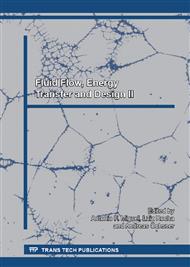[1]
P. Bujok: Underground Hydraulics I. Scriptum VŠB-TUO. (1988).
Google Scholar
[2]
D. Tiab, E. C. Donaldson: Petrophysics 2nd ed.: Theory and Practice of Measuring Reservoir Rock and Fluid Transport Properties. Boston, Gulf Professional Pub. 2004. XXVI. 889 p. ISBN 978-0-7506-7711-0.
Google Scholar
[3]
L.W. Lake, J.R. Fanchi: Petroleum Engineering Handbook 2nd ed.: Theory and Practice of Measuring Reservoir Rock and Fluid Transport Properties TX: Society of Petroleum Engineers. 2006-2007. 7 v. in 8 v. ISBN 155563124X7.
Google Scholar
[4]
O. Torsæter, M. Abtahi: Experimental Reservoir Engineering Laboratory Workbook. Norwegian University of Science and Technology. (2003).
Google Scholar
[5]
H.A. Nooruddin, M.E. Hossain: Modified Kozeny–Carmen correlation for enhanced hydraulic flow unit characterization. Elsevier. 2011. DOI: 10. 1016/j. petrol. 2011. 11. 003.
DOI: 10.1016/j.petrol.2011.11.003
Google Scholar
[6]
AMERICAN PETROLEUM INSTITUTE: Recommended Practices for Core Analysis, Recommended Practice 40 Second Edition, February 1998; Available from: <http: /w3. energistics. org/RP40/rp40. pdf>.
Google Scholar
[7]
Gases – Explosive and Flammability Concentration Limits` Available from: <http: /www. engineeringtoolbox. com/explosive-concentration-limits-d_423. html>.
Google Scholar
[8]
QIAN, X. -M., LIU, M., LIU, Z. -Y., SUN, W. -L.: Numerical simulation of methane leakage diffusion in the space with multi-buildings. (2009) Journal of Beijing Institute of Technology (English Edition), 18 (4), pp.388-394.
Google Scholar
[9]
KOUDELKOVA, J., BENOVA, E.: Risk assessment from the output of mine gases. (2012).
Google Scholar
[10]
TANGUTURI, K., BALUSU, R.: CFD modeling of methane gas distribution and control strategies in a gassy coal mine. (2014) Journal of Computational Multiphase Flows, 6 (1), pp.65-78.
DOI: 10.1260/1757-482x.6.1.65
Google Scholar
[11]
STAŠA, P., CHOVANCOVÁ, K., KEBO, V., CHOVANEC, J., KODYM, O.: Research of CO2 Storage Possibilities to the Underground; Procedia Earth and Planetary Science – Volume 6, 2013; pages: 14-23, ISSN: 1878-5220; DOI: 10. 1016/j. proeps. 2013. 01. 002.
DOI: 10.1016/j.proeps.2013.01.002
Google Scholar
[12]
STAŠA, P., KEBO, V., FUCHSÍKOVÁ, P., KUBÁČ, L.: Modelling potential action for building protection against flow of methane from the underground using the Fluent software; Proceedings of the 13th International Carpathian Control Conference (ICCC), High Tatras, Podbanské, Slovak Republic, 2012; IEEE Catalog number: CFP1242L-CDR; ISBN: 978-1-4577-1866-3.
DOI: 10.1109/carpathiancc.2012.6228732
Google Scholar
[13]
KEBO, V., STAŠA, P., BENEŠ, F.: Application of CFD programs and supercomputing in mining. In Mine planning and equipment selection; proceedings of the 22nd MPES conference: Dresden, Germany, 14th–19th October 2013. London: Springer, 2013, s. 899-910.
DOI: 10.1007/978-3-319-02678-7_87
Google Scholar


